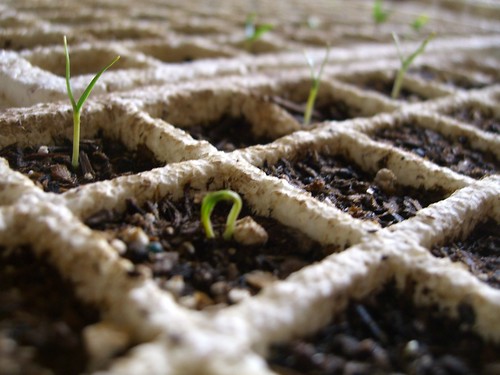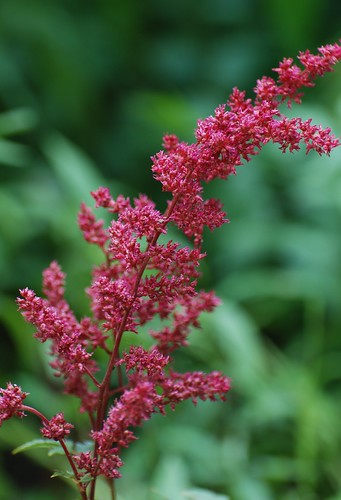Where does it come from, all this rain? Our village has been flooded a number of times in the last month, and billions (literally) of small stones about the size of a walnut have been washed out from the ancient quarries, up on the moors and have crashed into our gardens and messed them completely. The council have been out clearing the mess for days and there is more rain to come!
All that is nothing compared to my missing my old friends this summer. Let me explain.
I am the kind of gardener that simply loves plants. To me my garden is a home for a few hundred old pals who make an appearance, say hello, smile at me for their time and then move on. If pushed, I would say that garden design is less important to me than what plants I have about me. Actually this does get me into trouble from time to time, because I have been known to put plants in the ‘wrong’ place.

Photo by Benketaro on Flickr. Used under Creative Commons licence.
So, I spend my time looking at my seedlings, or the little green stumps covered by soil in the herbaceous border and wonder when my mates are going to make an appearance. I dream of summers where I say in my chair on the patio, surrounded by calling swifts, lobelia, alliums, lilies, and best of all for when I fall asleep – night scented stocks.
This year, however, they have appeared only to be bashed to death by millions of raindrops, or soaked so much that fungal infections brown the leaves and dull the nectar. Our best friends need to spend their time in hospital!
One thing I do for roses is to cover them with cartons, plastic drinks cups, collars, anything I have available. Another big help is to use some brushwood screening at different points in the garden to give a little shelter from the wind.
Artificial screening works well, and you can roll it up and pop it away until next time the low pressure sends us a windy deluge.
Another area for hospitalization is the herb garden. Plants like sage and mint need shelter from being bashed around, and a combination of horticultural fleece and the judicial use of the cold frame greenhouse will keep them in prime condition. I say judicial because the greenhouse can get warm if ignored – even when the sky is grey and black. Remember to open the flap to give your precious herbs a change of air, and stop them from growing too wet.

Photo by Aunt Owwee on Flickr. Used under Creative Commons licence.
It’s not all bad news, however. Fortunately Astilbes love this weather, they are already beginning to burst into flower, and all we need is a sunny day sometime soon to turn the earth grey flowers into a bright pink candy floss plant of wonderful dimensions. Transported into a fairground of pink, Astilbe turns a drab corner into something special. Can’t wait!
Then there are architectural plants I completely adore. Ferns look wonderful, a sea of acidic green splashing over our walled garden, in this case spattered with petals from the cotoneaster tree. Ferns have built in protection, a kind of internal armour of special wooded cells called sclerids, and no matter what the weather throws at them, they simply bounce over and stand up again. I think there is something to be learned from ferns – we so often try to force nature to our will, the fern has none of it, but simply falls over, gives way and then stands erect and proud.
Garden furniture needs a wipe down. We have a tree seat, and very elegant it is too. The problem is you never just get rain, you get rain plus leaves, rain plus bashed petals, dust, and even stones in our case! It’s always a good idea to go round your garden furniture and clean off the debris while it is fresh, rather than waiting and then realizing the debris is actually harder to remove than it could have been.
Of course, there is always plenty to do in the greenhouse. The tomatoes now have plenty of fruit, though they are later than last year, and the canes I have them tied to need re setting a little. The weight of the fruit tends to loosen the canes a little, so a push here and there does the trick.
Then there is the usual feeding / watering / removing side shoot regime that keep the plants in tip top fruiting condition. And it is time to transplant my pepper seedlings I have in my Lacewing mini PVC greenhouse into their final growing positions in the bigger greenhouse.
Since we have moved to a new home, our greenhouse is yet to follow us. Actually I am quite dreading the event! However, I have found the Primrose mini and walk in greenhouses an inexpensive and really effective replacement, and when the monster greenhouse does arrive, I will still be using these old friends too!
You see, gardeners make old friends out of so many things, plants, tools and even PVC greenhouses.

Paul Peacock studied botany at Leeds University, has been the editor of Home Farmer magazine, and now hosts the City Cottage online magazine. An experienced gardener himself, his expertise lies in the world of the edible garden. If it clucks, quacks or buzzes, Paul is keenly interested.
He is involved in an inner city program in Manchester which aims to encourage people to grow their own food whether they have a garden, an allotment, or even a balcony, as well as leading a co-operative initiative to train city dwellers to keep bees on allotments and gardens
He is perhaps best known as Mr Digwell, the cartoon gardener featured in The Daily Mirror since the 1950s. As Mr Digwell he has just published his book, A Year in The Garden.
